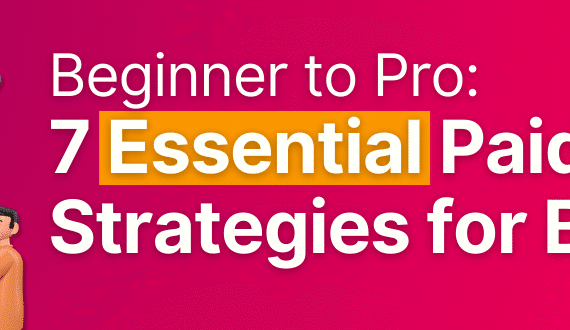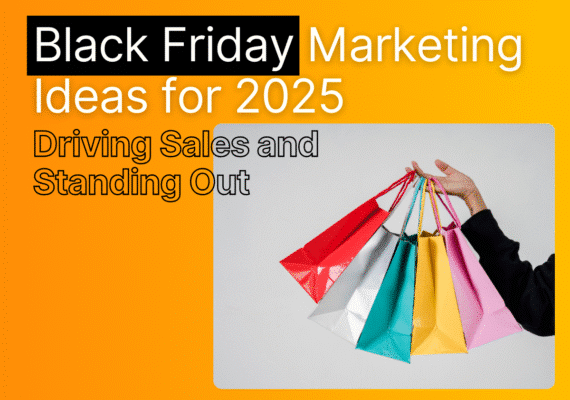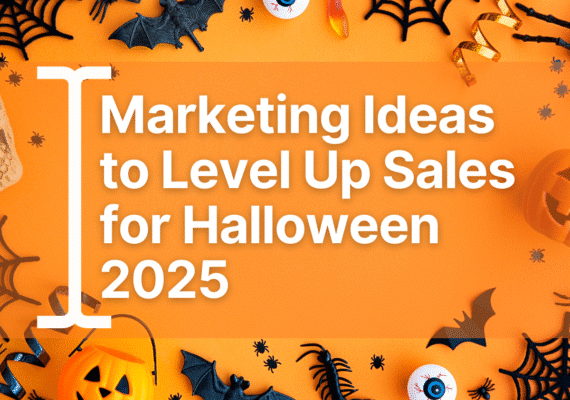Contents
Taking your marketing from here to there
Attending a marketing event and hearing about the latest trends and behaviours in the industry is always exciting… especially when the speakers include Stephen Bartlett, Mo Gawdat and Ameca The AI Humanoid and the host is Katherine Ryan. The From Here To There, a MailChimp event was insightful and provided great snacks and swag, which is all we really want from an event! Here are the key takeaways that we can all put into our marketing planning:
Brand trust and e-commerce in the current climate
In the e-commerce world, building connections and trust with your customers is crucial. As AI-generated content becomes more common online, trust will become the most valuable currency. People will increasingly rely on trusted sources rather than believing everything they see on the internet.
Some brands have lost the trust of their customers recently by greenwashing their messages and manipulating facts to come across as more environmentally conscious than they really are. Sustainability is no longer a USP for a brand, it’s evolved into a necessity. Consumers are making brand loyalty decisions and choosing who to trust based on corporate social responsibility (CSR) values.
Credibility and trust are usually given to brands with a larger voice. A mistake in the local newspaper may be forgiven whereas the same mistake in a national paper hits heavier, typically because we instil more trust in them. Applying this logic to marketing, One way that you can build trust is by building your reach.
A common way to build your reach, and subsequently your customer base, is through promotional strategies. Be careful with promos! Good promotions should align with your goals, whether these are increasing followers, email marketing subscribers or driving sales. A poorly planned promotional strategy can damage your brand by cheapening your product.
Pricing is a superpower in marketing. How you frame and anchor your price is more powerful than the price itself. Discounting promotions can be detrimental to your brand, they can anger customers who bought at full price and sales managers can become addicted to them. It’s not uncommon to experience sales slumps after a promotional period, so you do what worked before to increase sales, and run another discount promotion, which causes another slump, and so on.
Instead of cheapening the price of a product, think of other methods to help hit your targets:
- Offer early access to new products, to those who have purchased recently.
- Limited edition products, only available to those who follow/subscribe.
- Free gifts that add value to a target order value without devaluing the product.
This doesn’t mean you can’t ever run a discount promotion. For a brand with a goal to increase your email subscribers, where they are unbothered by the current profit margin, a discount promotion to encourage people to refer a friend would be successful. Always ensure your promos add value both for you and your customers.
AI to save time and let your team come up with the ideas
AI has been a hot topic for the past few years, particularly since the launch of ChatGPT. The roots of AI go back to the 1940s, but significant advancements have been made since 2012, which is when science fiction into reality.
Artificial Intelligence (AI) has revolutionised the marketing landscape, offering hyper-personalization, AI-driven analytics, and immersive brand experiences. However, it’s not replacing human marketers yet. Ask ChatGPT to write a blog and you’ll quickly understand the strives it needs to make if it wants to replace jobs in marketing. While AI can simulate human-like tasks, it cannot fully replicate the nuanced creativity and emotional intelligence of humans.
The most exciting aspect of AI in the workplace today is its ability to automate tasks, freeing up your team to focus on creative and strategic endeavors. The true strength of a team lies not in the tools they use but in their expertise. AI can streamline processes such as data pulling and handovers, allowing your team to spend more time brainstorming and less time on mundane tasks. Remember, AI won’t solve all your problems, but it can make many of them easier to manage.
The rapid acceleration of AI technology is unparalleled, but Spiderman’s Uncle Ben famously said, “with great power comes with great responsibility”. Existential risks are often forecasted when speaking about AI, however, it’s equally important to focus on the positive potential of AI.
AI can enhance marketing with hyper-personalisation, creating an audience of one. Optimisation with segmentation, previous purchase history, preferred send time and send day, are AI account data analysis tools we are already seeing in marketing platforms. The best marketing campaigns help tell a story that customers can immersive themselves in. One of the most overwhelming marketing campaigns recently was the Barbie Movie, this took over both the physical and virtual world, you couldn’t turn a corner without seeing pink. AI will help marketers build immersive campaigns like this that resonate with individual consumers, tailoring each story to the individual.
The best ideas will always be what matters most, and AI tools are there to execute these ideas efficiently.
Just because you have a social media page doesn’t mean you have a community
The world is increasingly enslaved to dopamine, with people seeking short bursts of this “feel-good” chemical. Social media platforms know this and have built their algorithms are to exploit our addiction, showing a mix of boring and exciting content to manipulate our emotions and keep us scrolling for longer; similar to how casinos in Vegas keep gamblers at tables with different emotional manipulation tactics.
This cycle can leave us feeling more empty and unfulfilled over time. When social media platforms claim to bring people closer together, do we think this promise has truly been fulfilled? We can ask the same question about the internet as a whole. Has the internet made us more knowledgeable, or has it fallen short of its potential?
The internet comes with big promises of success, but the true determining factor of success is not the internet itself—it’s you. Simply having a social media page doesn’t mean you have a community, just as having PC ads and a website doesn’t guarantee conversions. These tools provide the potential, but they require effort and optimisation to achieve meaningful results.
This is a common conversation with our clients: “We have an Instagram account, but it’s not doing anything for us.” Having the tools is just the beginning; optimising and actively working on these platforms is essential to deliver the desired outcomes.
You can learn how to optimize your marketing strategy, but the abundance of information available can be overwhelming. With countless resources on Google, it’s easy to feel overwhelmed and find excuses not to dive into the information. One effective way to cut through the noise is to participate in training courses or seek help from experts who can optimise your strategies and help you achieve your goals. By doing so, you can focus on what truly matters and leverage marketing and social media to its fullest potential, turning possibilities into reality.
Too many marketing strategists and not enough simple strategies
One scroll through LinkedIn and you’ll quickly see that there are more strategists in marketing today than ever before, however, that doesn’t necessarily mean that we have better marketing strategies than ever before. If anything, more strategists have meant we have more complex strategies, with each strategist trying to put their unique spin on the marketing ‘winning ticket’.
However, more complex strategies aren’t a requirement for a winning marketing campaign. Keeping your strategy simple allows your energy to be spent on delivering successful campaigns and their execution.
Creating a simple marketing strategy starts with asking yourself three key questions:
- Who are you targeting?
- What is your position regarding these targets?
- What are your objectives for the upcoming period?
Avoid getting bogged down in tactics before you’ve answered the fundamental strategic questions. Step one of any marketing strategy begins with diagnosing and understanding your consumer and looking at your business from their perspective. It’s easy to get caught up in thinking competitors are the businesses closest aligned to yours, however, your customers may see alternative options as something entirely different, not just the business with the closest aligned service offering. For example, a cinema’s biggest competitor may not be another cinema it may be a bowling alley.
Something that will help create a more interesting marketing strategy without sacrificing your strategy to becoming more complex, is a diverse marketing team. Diversity in your marketing team leads to better performance, and the ability to draw on different perspectives fosters innovative solutions and more effective strategies. Additionally, multi-channel communication outperforms solo-channel campaigns, reaching customers through various touchpoints and increasing engagement.
The long and short of marketing
Successful marketing requires delivering short-term results, whilst not ignoring the, sometimes overlooked, long-term. Although hitting monthly and quarterly targets is an immediate focus, it’s likely most of your audience isn’t in the market right now, which is why the long-term can’t be overlooked.
Mark Ritson suggested allocating a larger budget to brand awareness to help set you up for success in your future short-term campaigns. Think of KitKat as an example, if they only focused on the short-term they would only invest in point-of-sale marketing. However, when you think of examples of KitKat’s best marketing, you probably think about their brand marketing reinforcing the “Take a Break” message.
The cost of not taking risks
An industry trend that Rory and Stephen discussed was businesses shifting towards redefining their customer base by conversion cost, aiming for the cheapest option. However, it’s important to think beyond acquisition to the lifetime value of a customer. Sometimes, investing in acquiring a more expensive customer will be more valuable than a peak in short-lived customers.
“The best measure of a great company is repeat business” – Rory Sutherland
Stephen Bartlett is known for fostering a culture where experiments are encouraged, and failures are not punished. He has taken a lot of risks in his career and when asked about how he justifies experimenting with his marketing, he believes one successful experiment can outweigh the graveyard of unsuccessful ones. It was clear from the discussion that both rory and Stephen admit Jeff Bozos’s approach of embracing risk and experiments in business, they shared Jeff Bezo’s two-way-door way of approaching risk. Many marketing departments agonize over decisions but this approach encourages teams to evaluate whether it’s a reversible decision. Check if the door is a two-way door that you can step back through if it doesn’t work out, if you can step back and reverse a decision, there’s less risk in trying new approaches.
Fundamentally, if you’re not adopting a risk-taking culture you’re not innovating, which means you’re standing still in a fast-moving world. Without experimentation, you could find yourself in a Blackberry situation, where the industry has surpassed you and you’re trying expensive hail marys to catch up.
The power of affiliates
Affiliate marketing has experienced a whole 360, it was popular in the 90s and 00s but with the rise of social media, search ads and display ads, it was forced to take a back seat for a while. The rise of social media influencers offered an alternative to affiliate links on a blog or website with an agreed amount of promotional posts for a flat fee shared with their followers. TikTok merged the lines of influencer and affiliate marketing, offering creators an affiliate bank of products that they can choose from and promote through TikTok shop, creators then earn payments when their audience purchases the product through their videos/posts.
You may think it’s too early to talk about Christmas, but the truth of the matter is that Christmas time is a densely competitive period when brands battle for promotional space. From social media and press articles to promotional ads and everywhere, there is a fight for products to be shown. However, any B2C marketer will tell you that Christmas promo is often left too late to execute everything on the wish list.
If there is one thing that will help set you up for more visibility of your products, it’s affiliate marketing. Getting these foundations in place before the season is near will help secure more spotlight product placements in editorials and get your products from TikTok shop on TikTok Livestreams or promotional videos.
Increasingly, Journalists are being incentivised with affiliate link targets, if you’ve got an established affiliate link that has already been approved and used in their publication, you’re giving yourself a higher chance of your press release being accepted when you need it.
Marketing your marketing
Sometimes it can be challenging to get others to see the value of the entire marketing campaign, especially when it comes to marketing without immediate results. Within the industry, there is almost an unspoken language of marketing, but it’s important to translate this to anyone who might not understand. Rory compared the marketing industry language to when people talk about astrology with “Mercury in retrograde” and “Jupiter rising”, although you might understand the words someone is saying doesn’t mean you understand the impact of the words which may lead you to miss the point entirely. Many businesses want immediate ROI or ROAS, this is easy to track with performance marketing but much harder for long-term campaigns like SEO or branding. Stephen suggested the analogy of brushing your teeth to demonstrate the value of SEO: the immediate effects may not be visible, but the long-term benefits are undeniable. Consistently engaging in SEO practices might not yield dramatic overnight changes, but neglecting the SEO of your website could result in significant disadvantages down the line.
If you’re looking for training, need a strategy or would like support with your marketing efforts, then get in touch today and we’ll be happy to talk about your requirements.






